
Your Toolkit for Becoming a More Data-Driven Association
Becoming a data-driven association starts with understanding the data you have, then making it available and practical for your team to use. Let’s dive into how you can make this happen.
Your association probably has access to a lot more data than you think.
But knowing what member data you have access to and knowing how to use it are two different things. If you’re sitting there worrying over giant digital transformation projects, an overwhelming amount of data, or how to operationalize it, you’re not alone.
So many resources talk about “data-driven decision-making” as this big, scary thing. But really, becoming data-driven is just about taking the data you have and using it to make decisions.
That’s it.
Did you miss the first or second session in our Member Data series? No worries, you can read the rest of this blog post for a recap, or watch the first on-demand session here.
Check out the three webinars in the series, featuring panelists from Wicket, CSAE, and Higher Logic.
Becoming a Data-Driven Association is Easier Than You Think
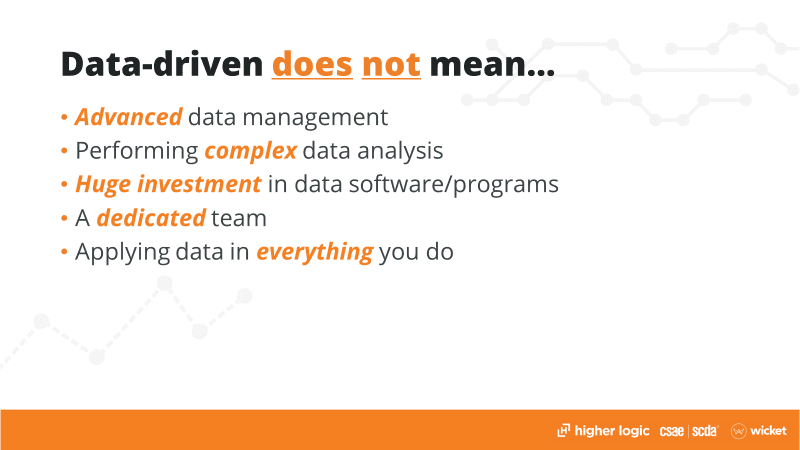
You don’t need to be a data scientist. You don’t need to invest in complicated data analysis and opaque algorithms. You don’t even need a dedicated team.
Becoming a data-driven association (and becoming more member-centric) starts with understanding the data that’s available to you, then making it available and practical for your team to use in an accessible, understandable, and relatable way.
Your team needs the context to understand why each metric is important and how it impacts the bottom line. If someone gave you a dollar, and they had no frame of reference for what a dollar was worth, they would just throw it away.
Without context, that’s exactly what will happen with your data.
Ready to advance? Check out the member data project framework we discussed in session #2.
It’s your job to make the connections between the data you have and how to use it to make decisions to meet your goals.
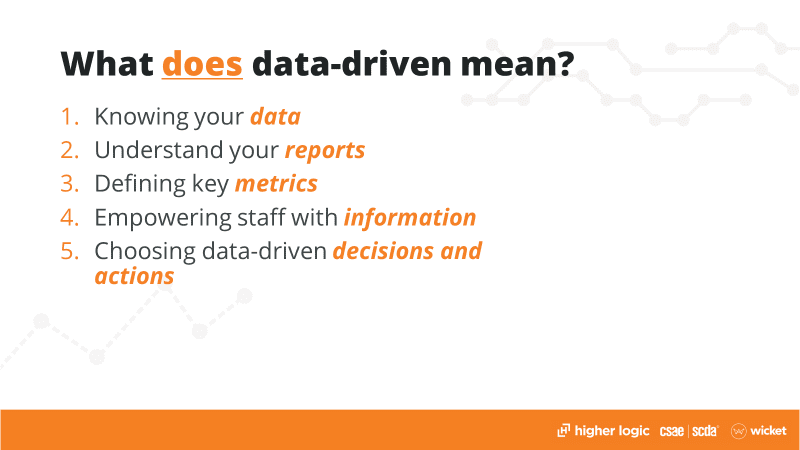
As an association, you have a responsibility to know your members. The more members you have, the harder that will be. But if you’re properly collecting and analyzing that data, you can give your members a better overall experience, like sharing the right messages at the right time in the right format. That’s what’s going to serve them.
What Becoming a Data-Driven Association Looks Like in Practice
Let’s start at the beginning: understanding your data.
If you want to maximize your understanding of your members, ask yourself these questions: Why collect this information? Who uses it? Why is it important?
Building an Internal Process that can Scale
Start with an internal champion. Becoming data-driven doesn’t happen naturally. Someone in your organization needs to “own” data. It doesn’t have to be a data genius, just someone committed to ensuring the data is clean and the definitions are understood.
Second, you need to define your metrics.
“You need to focus around what key metrics look like. What are the words you use, internally? And when you say something like ‘active members,’ what do you really mean? If you ask everyone in your organization, will they say the same thing?”
– Jeff Horne, CEO at Wicket
Build a data dictionary to ensure everyone is clear what terms like “active members,” “inactive members,” “retention,” “upsell,” or “engagement” mean. It can be as simple as a 10-row spreadsheet with a term and a quick definition, but document it. Then save it and refer to it often.
From there, you can set goals. How do you define those terms in data? What do you want to do with the information? What questions do you have?
Once you understand what information you need and why, you can focus on the day-to-day operations that make data-driven decisions happen, like managing a clean database, pulling reports, and generating specific insights for your team.
Using Segmentation to Deliver A Better Member Experience
The biggest way you can better serve your members with data — and make your life easier — is segmentation.
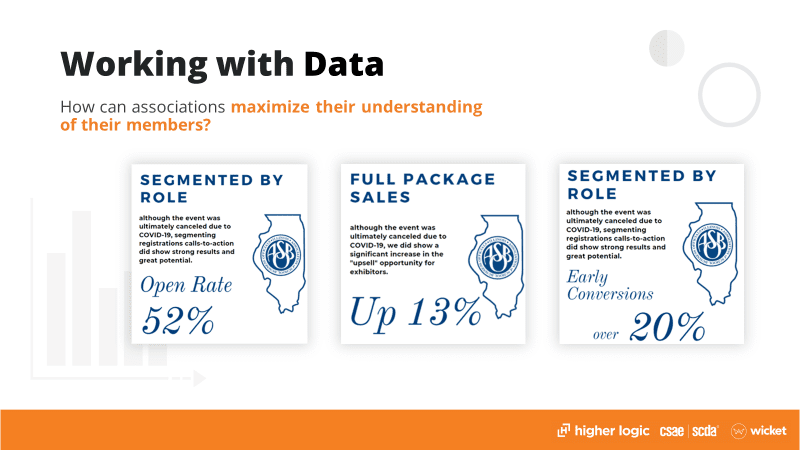
“Segmentation is critical. By delivering the right message to the right people as painlessly as possible, we have that better opportunity to activate and talk to that member at scale, in a way that’s much more effective in driving internal efficiency.”
– Josh Slyman, Sr. Consultant at Higher Logic
Segmentation doesn’t have to be complicated. You can use data you already have, like using a role to change a call-to-action or a piece of content in an email. For the Illinois Association of Business School Officials (IASBO), implementing segmentation in an email campaign translated to 52% more opens, 13% more upsells, and 20% more conversions for their event campaigns.
It’s not about personalization anymore — it’s about the personal.
Getting personal with your members makes a big difference. “Hi, ‘First Name’” is just personalization, not personal. Once you start segmenting, you can get away from simple personalized email blasts, and instead deliver tailored messages that see higher returns across platforms, without a lot of extra effort.
“Working in an association, I’m always thinking about the benefit to our members. When we get new information, we always find a way to benefit the member through it. The more we gather, the more we can filter and segment for their benefit.”
– Vasan Selliah, Member Insight and Engagement Manager, CSAE
5 Common Mistakes Associations Make with Data (And How to Fix Them)
If you’re just beginning your data journey, there are a few pitfalls to watch out for. Even data experts can get tripped up sometimes.
The one thing you won’t have to worry about? Data volume.
“I’ve never run into a situation where there’s no data anywhere, and nobody has any ideas of what to do. A lot of the mistakes I’ve seen come from not taking the time at the beginning to work together and figure out what data you need, why you need it, and what you want to do with it.”
– Nicole Covello, Data Analyst at Wicket
Mistake #1: Re-Inventing the Wheel
With data-driven projects, you don’t have to start from scratch on content. Data should fold into the processes you already have. Re-inventing a process or starting from scratch only makes things less efficient — so don’t!
Fix it: Incorporate data into your existing projects, rather than starting something new. If you’re working on improving your member retention, set up a dashboard to monitor your performance or start experimenting with segmentation. Work on what you’re already planning to work on, just do it with data.
Mistake #2: Going Too Big
Once you start looking into data, you will find it everywhere. There are so many applications for the information that your head may start to spin, and soon you’ll have a laundry list of a hundred “nice to haves” with no prioritization that will make you want to tear your hair out.
Fix it: A huge list will overwhelm you and your team. Start with a small project with clearly defined a goal, then build from there. Know the exact list of metrics you need, but more importantly, how you’re going to use them. Then focus on the one or two metrics that really matter to you this quarter.
Mistake #3: Asking for Too Much
Your members know you’re going to use their data, but so many associations ask for tons of information they never plan to use. When your members fill out their profiles, are you asking for information you don’t need? Do you ask for so much that it actually creates a barrier to getting any information at all?
Fix it: Reduce form fatigue by paring down member profiles to only ask for information that’s actually useful. If you’re going to ask for their birthday, for example, make sure you’re sending an email to wish them a happy birthday. Whatever the information is, have a plan for how you’ll use it, and don’t ask for it all at once if you don’t need it. You can ask for more later.
Mistake #4: Keeping Data Siloed
You can’t make decisions with data if you don’t have the whole picture. Documenting your data progression over time — whether it’s in dashboards, reports, or good, old-fashioned spreadsheets — will show you what matters and what doesn’t. Without benchmarks across every department, you’ll never be able to put the pieces together.
Fix it: Make your data accessible and relevant to everyone in your organization. The more data you’re able to use, the better cross-platform behavioral understanding you’ll have, leading to a better member experience, improved retention, non-dues revenue (NDR), and acquisitions.
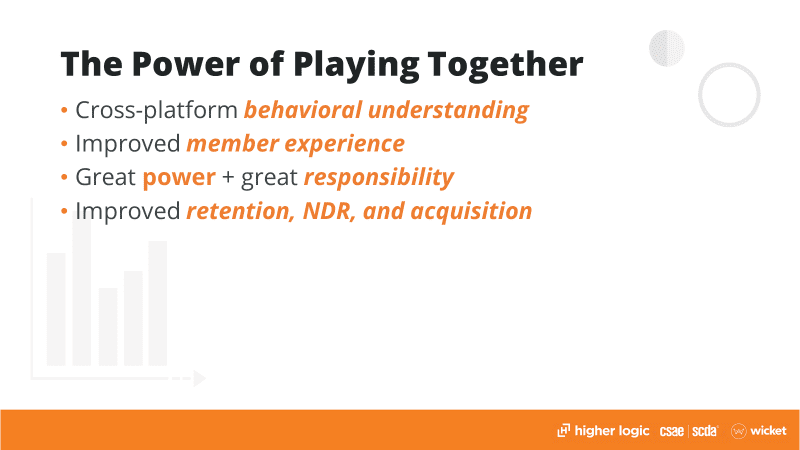
Mistake #5: Poor Data Management
Anytime you collect data, you need to make sure you’re using the right tools to keep it secure. The more tools in your tech stack, the more opportunities to lose track of your data. And the more systems you have, the more likely you are to lose track of things like opt-outs, which are critical to complying with laws and regulations.
Fix it: Invest in tools that integrate. For example, Higher Logic is an online member community and communications platform that integrates with many common association management systems (AMS) and customer relationship management (CRM) software platforms. This makes collecting, managing, and using all of your member data in one place easy.
How to Get Started With Member Data
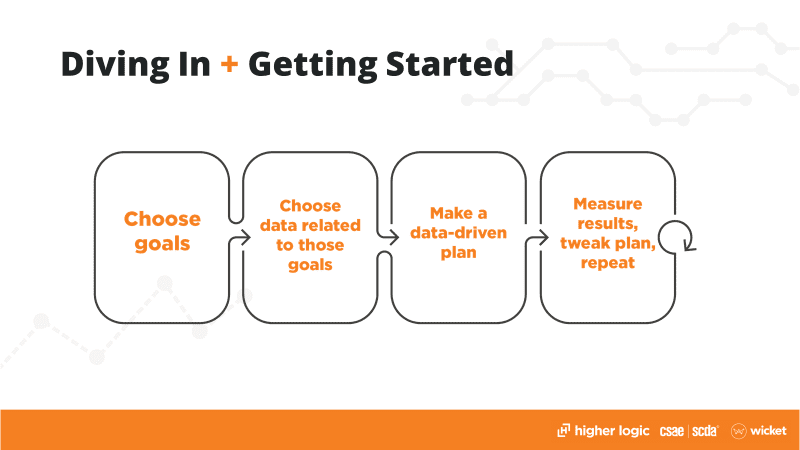
Now it’s your turn. When you’re ready to dive in, follow these steps:
- Choose your goal. Understand your metrics. Define what they mean and why they’re important.
- Choose data related to those goals. Know what pieces of data add up to a goal. For example, if you want to acquire new members, start with your website traffic, non-member email subscribers, and non-member event attendees.
- Make a data-driven plan. How will you incorporate data into the project? At what points will you change course based on certain information? What are your benchmarks, and where do you want your member to go?
- Measure results, tweak, and repeat. Testing and adjusting is the key to success. Use data for continual improvement to reach your goals.
This was just a recap of session #1 of our Member Data series with Wicket, CSAE, and Higher Logic! Sign up for sessions #2 and #3 here, where we’ll cover exploring your data and turning insights into action.


